Serial Series
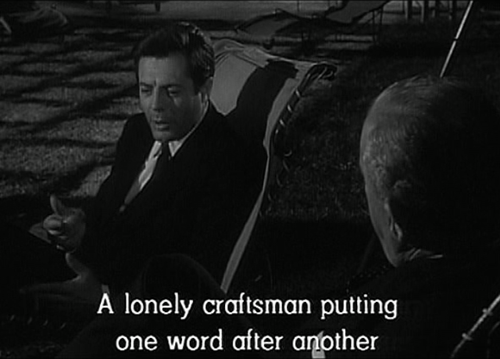
Above: a subtitled still from Michaelangelo Antonioni’s La Notte, one of Stanley Kubrick’s top 10 favorite films. Watch the entire scene here.
Serial Series is a six-part meditation on the production of text from the text’s point-of-view. It was written serially and published serially during the three-week run of Dexter Sinister’s *The First/Last Newspaper, a project for Performa 09.*
1 — NEWSPAPER TAX LEVIED: FEW CAN AFFORD DAILY 6 PENCE



Above, from top: Gutenberg, Manutius, Dickens.
Text takes time. It takes time to read, it takes time to write, and it takes time to reproduce. Throughout the history of text production, people have been searching for ways to distribute the costs of producing text — financial, temporal — more evenly across a system. This search led a former goldsmith, Johannes Gutenberg, to develop and refine his system moveable type by the 1450s, which eliminated the laborious book-copying process used previously by monastic scribes. And with Gutenberg’s system in place, Venetian publisher Aldus Manutius was able to quickly popularize printed books by the late 1400s.
As text becomes easier and cheaper to produce, more copies of it get made. While Gutenberg’s Bible was printed in a small edition of 180, Manutius’s books were printed by the thousands. More copies need more readers and most readers like their text to be portable. While Gutenberg’s heavy Bible was best read at a library table, Manutius’s slim editions could be easily slipped in a saddlebag or vest pocket. You went to Gutenberg’s books, but Manutius’s books went with you. As increasingly numerous and increasingly portable copies of texts found their way into the world, they found new readers to buy them and they spread literacy with them.
In the next two hundred years, text continued to get swifter, more portable, and more widely distributed, giving rise to a new form by the late 1600s and early 1700s: the newspaper. By now firmly established in Europe and North America, the newspaper’s growth was spurred by a flowering of global trade. Access to time-sensitive political news and financial information was increasingly important, and publishers strived to invent new technologies to meet demand. By the early 1800s, as a result of the industrial revolution, the Times of London boasted a press that could print a daily broadsheet at 1,100 pages a minute, with a circulation to match. By 1830, presses could print on both sides, saving paper, and the “penny press” was born, offering a product that cost 1/6 of the competition’s price. Once again, more copies, cheaper copies, smaller copies meant better distribution of costs, and, as a result, ever more readers.
As the cost of mechanically reproducing text fell, the cost of circulating printed texts fell with it. According to historian N.N. Feltes, the fruits of the industrial revolution — like “paved roads, fast coaches, canals, and, eventually, railways” — made it easier to deliver printed texts to their intended audiences. Around the same time, firms that were known as “booksellers” shifted away from selling each other’s books and instead re-established themselves as something more like the publishers we know today, wholesaling their own books, but not, Feltes points out, “anybody else’s.” This concentration of efforts along a single product line did the trick. After all, it does no good to deliver more printed texts to readers if the demand from those readers isn’t stimulated at the same time. Some of these same fruits of industry that cheapened the cost of circulating text were used to drive up demand: traveling salesmen were dispatched bearing cheap printed prospectuses and catalogs to hawk a publisher’s wares to a more geographically dispersed audience. On those same trains and ferryways were newspapers, streaming from the center of cities and featuring paid advertisements for books and, increasingly, the free publicity of literary reviews.
Books were cheaper than ever to print, and they were cheaper, faster, and easier to distribute. Readers were increasingly aware of new books on the market, and, because of the new industrial age, they were increasingly able to find leisure time to read them, all of which set the stage for a flourishing of the Victorian appreciation and consumption of literature. Costs fell, distribution climbed, demand grew, but one variable was not improving. It still took authors a long time to produce a text, and, even given their best efforts, there was no guarantee to publishers that an author’s work would ignite the passions of an ever-widening public.
Again, it was the newspaper to the rescue — or, rather, the technology developed for the newspaper industry. When a greedy and disapproving British government levied a tax on the newspaper industry starting in 1712, it grew over the next century to 4 pennies. Printers began producing pamphlets instead. Through a loophole in the tax law, pamphlets, which were larger than newspapers, were not taxed and were only marginally more expensive than newspapers to produce. While few people could afford the daily cost of 6 pennies for a 1- or 2-page newspaper, the occasional cost of a 12-penny (or 1-schilling) pamphlet of 48 pages seemed more justified. Printers naturally gravitated toward pamphlets and began filling the additional space required with more advertising, fiction, and other miscellaneous content.
Some printers realized that this new content was more popular than their news coverage and began recruiting proven authors to publish exclusively in the pamphlet format. Generally, these small booklets were called “numbers” or “serials,” but more specifically they evolved into a range of forms including the part-issue, the three-volume, the bimonthly, and the magazine-serial. Effectively, the serial unbound the singular book, reformulating it into a series of installments. In doing so, it instantly appealed to publishers and booksellers by lowering risk. If an author’s work did not appeal to the public, at least publishers had not put all their eggs in one basket. But the serial also increased demand: not only was the serial more reasonably-priced than newspapers, but it was far less expensive than books. The serial was a book on an installment plan. They were wildly collectable — and more portable, too. Best of all, the serial kept a writer in the public eye for months, even years, at a time, as a story’s suspense built chapter by chapter. Now, the time it took an author to compose a text was not a liability, but an asset.
Charles Dickens was an author who’d proven himself in the newspaper trade. Starting in 1833 with his first story, “A Dinner at Poplar Walk,” his short essays, or “sketches” of everyday life, had proven popular with the general public. Dickens’s first novel, The Pickwick Papers, debuted as a part-issue in 1836, around the same time the House of Commons voted to reduce its tax on newspapers to just 1 penny. With this final regulatory barrier minimized, all the elements needed for a vigorous mass media were in place: it was time for a runaway hit.
Dickens delivered. The first part-issue of The Pickwick Papers was a modest edition of 1,000, but, with the introduction in Chapter 10 of Sam Weller, Mr. Pickwick’s servant, demand exploded. Working-class Londoners couldn’t get enough of Sam’s Cockney wit and wisdom. By the end of the serial, Dickens’s circulation had expanded 40-fold. The author was a bone fide literary star, and the Victorian appetite for “novels in numbers” was raging.
2 — TIME CAPTCHA’D FOR GLOBAL GOOD?
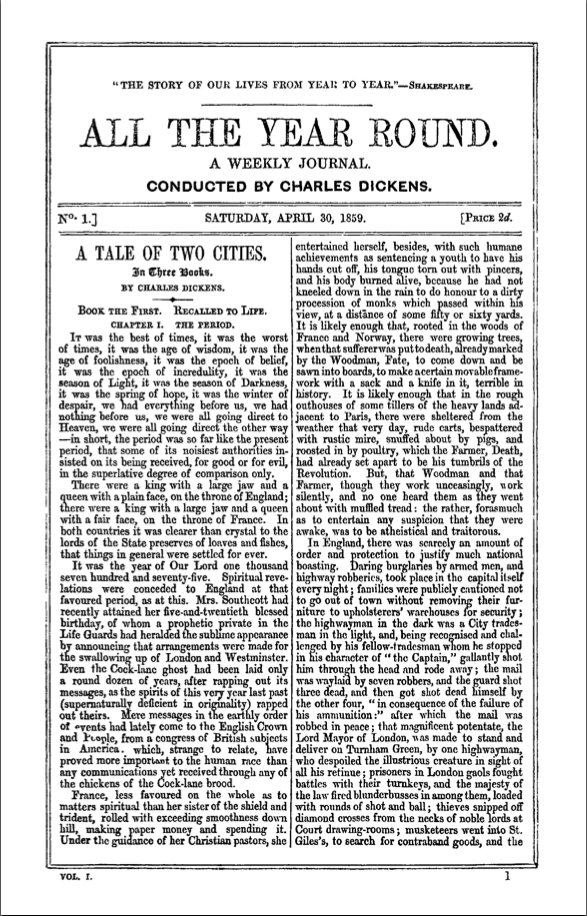
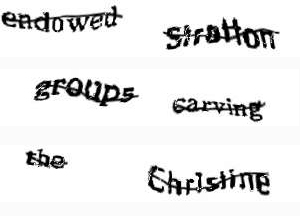
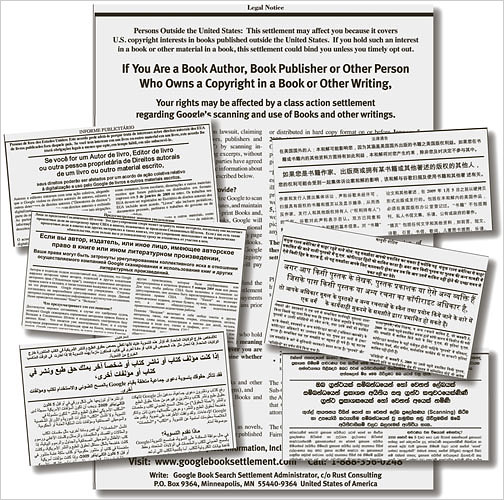
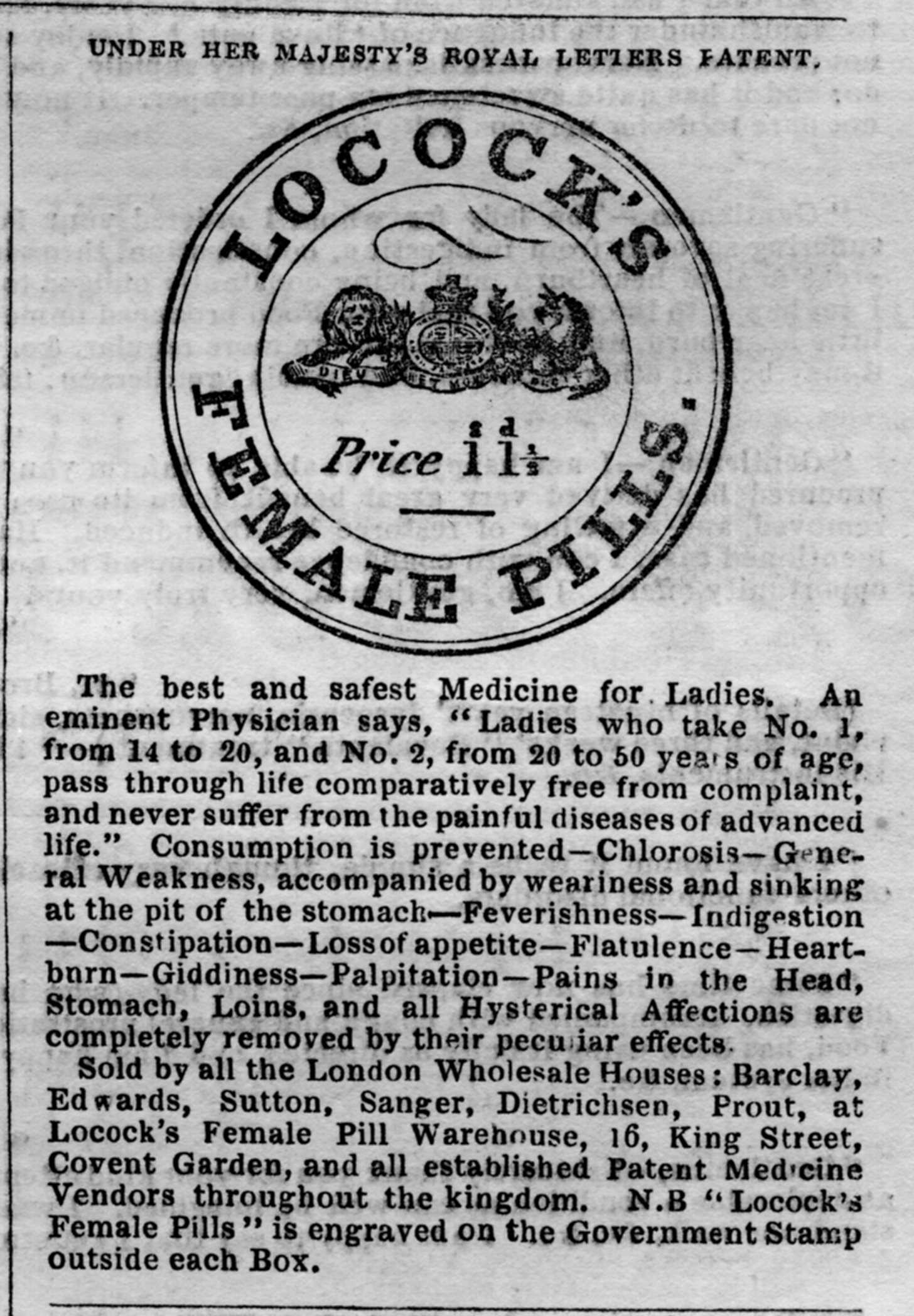
Above, from top: The first page of A Tale of Two Cities, from Stanford’s Discovering Dickens; a modern CAPTCHA; international ads placed as part of a Google Books settlement; an ad for Locock’s Female Pills that appeared in a Dickens serial.
In 2002 Stanford University launched a “community reading project” called Discovering Dickens, making Dickens’s novel Great Expectations available in its original part-issue format and asking Stanford alumni and other members of the Stanford community to read along, exactly as Victorians first did, with the serial version that appeared from December 1860 to August 1861. In 2004, as Discovering Dickens readers were enjoying A Tale of Two Cities, Stanford joined the newly-formed Google Print Library Project, along with the University of Michigan, Harvard, Oxford, and the New York Public Library. A year later, the program would become know as the Google Books Partner Program, or, more simply, Google Books.
At the launch of Google Books, Google’s intent was to scan and make available 15 million books within ten years. By 2008, just four years into the project, 7 million books had already been scanned. When books are scanned, words are automatically converted by Google’s Optical Character Recognition software into searchable text. Occasionally, there is a problem with this conversion process, and Google’s OCR software either can’t recognize some text or it isn’t confident about its conversion, having checked the results against standard grammar rules. The only way to convert these wayward words and phrases is to introduce human eyes into the system. This September, Google did just that with the purchase of reCAPTCHA.
ReCAPTCHA was invented by Luis Von Ahn, who also invented the CAPTCHA, which is a test that can tell if a user is a human or a computer. CAPTCHAs are effective at blocking spam, verifying accounts, and a variety of other online tasks. Von Ahn’s original CAPTCHA presented a randomized set of letters warped in such a way that a computer could not read them, though humans easily could. A few years ago, Von Ahn started thinking about the time people were wasting filling out CAPTCHAs. It bothered him. About 200 million CAPTCHAs are solved everyday. Each one takes about ten seconds of time to solve, so collectively people spend more than 150,000 hours a day solving CAPTCHAs. What if this time could be harnessed for the global good? Von Ahn found a way: instead of random letters, his new system, reCAPTCHA, presents users with two English words, one known and the other unknown. The unknown words are pulled randomly from a pool of scanned words that OCR cannot convert. Users solving reCAPTCHAs require the same amount of time as before — ten seconds — to recognize and type these two words. But now, every test produces a human user confirmation and the digitization of an unknown word. ReCAPTCHA digitizes 45 million words a day, or about 4 million books a year. In addition to the words reCAPTCHA digitizes for Google Books, reCAPTCHA’s other significant source of unknown words comes from the archive of the New York Times.
The case of reCAPTCHA once again underscores the fact that text takes time. Even the seemingly insignificant act of parroting back some random letters or words occupies us for a collective 150,000 hours everyday. But while the typical production of text is made by one or a few writers producing words serially in sentences one after another, reCAPTCHA has its millions of users producing text randomly, separating words from their proper context and syntax and presenting them to us based on their ambiguous form and unlikely transliteration instead. Rather than invention, reCAPTCHA’s method is algorithmic. And rather than originality, reCAPTCHA’s reason for generating words boils down to one thing: verification.
Verification is also central to the snarl of issues surrounding the legality of the Google Books project more generally. Many works it has scanned, like Dickens’s writings, were already free of copyright and in the public domain long before the project started. (Mark Twain’s The Adventures of Huckleberry Finn, which entered the public domain in 1942, was first published in 1884. Dickens died in 1870.) However, many of the works Google Books has scanned are still under copyright, and Google has scanned them anyway in an attempt to make them more accessible — similar to a “card catalog,” according to Google — however, authors’ and publishers’ rights groups have objected to this and sued Google to stop them from scanning works under active copyright. For another large segment of the books Google has scanned, the copyright status is simply unknown. So-called “orphan” works, under copyright but now out-of-print, are those works for which, after a “reasonable effort” has been made to locate a current copyright holder, no such person can be found. On one hand, Google must attempt to verify whether or not a current copyright holder exists. On the other, it must verify to the court that it has been exhaustive in conducting its search in order to make the book available to users of Google Books. And this two-part effort has led to what the New York Times described earlier this year as A Google Search of a Distinctly Retro Kind. The article continues,
Since the copyright holders can be anywhere and not necessarily online — given how many books are old or out of print — it became obvious that what was needed was a huge push in that relic of the pre-Internet age: print. So while there is a large direct-mail effort, a dedicated Web site about the settlement in 36 languages and an online strategy of the kind you would expect from Google, the bulk of the legal notice spending — about $7 million of a total of $8 million — is going to newspapers, magazines, even poetry journals, with at least one ad in each country. These efforts make this among the largest print legal-notice campaigns in history. That Google is in the position of paying for so many print ads “is hilarious — it is the ultimate irony,” said Robert Klonoff, dean of Lewis & Clark Law School in Portland, Ore.
Klonoff’s comment is apt. In its attempt to digitize all the world’s books, Google has not only been forced to search for what it cannot find, but the company, which made its billions by serving relevant advertisements to users of its search engine, must now spend millions placing similar ads in tiny publications that its Google Books service (and the scanning of books more generally) may ultimately render obsolete.
For readers of Discovering Dickens, Google’s hundreds of little text advertisments may seem reminiscent of the ads scattered throughout the original part-issues of Dickens’s serial works, each of which included 16 pages of advertising flanking 32 pages of original text. The benefits of the “Invisible Spine Supporter” and “Dr. Locock’s Female Wafers” were proclaimed alongside entreaties urging buyers to purchase “Alpaca Umbrellas” and “Children’s Frock Coats and Pelisses.” It was a bazaar inside of Bleak House, a marketplace within Martin Chuzzlewit. For Dickens’s publishers, his text provided a perfect vehicle for additional advertising revenue. But, with the aid of the recently developed idea of copyright, Dickens’s text would soon become a commodity of its very own.
3 — NEW LEGISLATION COMBATS CHICKEN-EGG PROBLEM
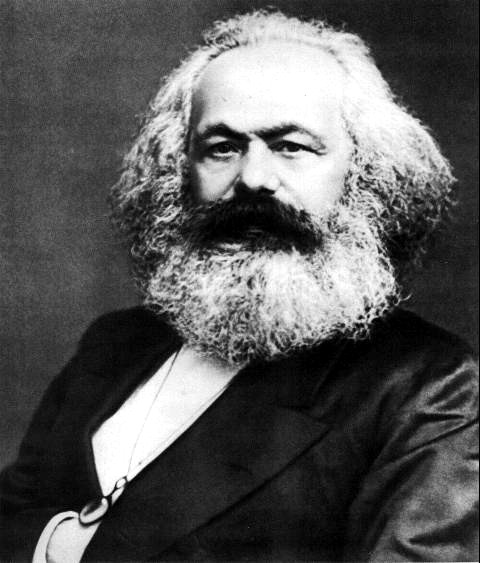


Above, from top: Karl Marx; hand-loom weavers; a coin with Queen Anne’s likeness, 1708.
British literary historian N.N. Feltes has said that “Readers are made by what makes the book.” Meaning, the system that produces a text also produces the readers who read it. In Charles Dickens’s case, that system was serial publication. But, in Dickens’s case, that system was also the nascent industrial revolution, which involved the shift from what Feltes describes as the “petty-commodity production of books,” in which books were produced in small quantities by artisans, to the “capitalist production of texts,” in which books were produced in mass quantities by professional printers and publishers. In a very short time, the system that produced a book went from something like that which produced a homespun quilt to something like that which produced bolts of industrially-woven fabric. While the machines made the fabric cheaper and easier to make, its weavers owned nothing but their labor in making it. And while presses made books cheaper and easier to make, their authors in turn owned nothing but their power to conceive them.
The comparison of writing to weaving is not lost on Feltes, who uses it to recall Marx:
While the condition of early 19th century writers could never decline to that of their wretched contemporaries, the hand-loom weavers, nevertheless Marx’s comment on the weavers’ predicament in the face of the new relations of industrial production is illuminating.
Marx noticed that workers in a capitalist system are estranged from the work they make. Since their work is no longer their own, the concept of labor arrives to take its place. This yields, as Marx says, “the conditions of labor and the product of labor.” The book, which was once the work, is now the product; its text, which was also once the book, is now the labor. Its author’s right is not to the product but to his or her individual labor. In one stroke, the “professional author,” and the “commodity text” were born, along with the mass-consuming public to support them.
With the serial, all three were perfected. “Rarely has a literary form been so driven by the dictates of economics,” explains writer Shawn Crawford in his essay No time to be idle: the serial novel and popular imagination. And Dickens’s success became the gold standard. Crawford:
Along with his writing talents Dickens possessed an acute business sense that made him a ruthless bargainer. He recognized the power an author could wield if used wisely. He often negotiated royalties of up to 75 percent of the profits, received [large] advances, and commanded an allowance whenever in the midst of publishing a new work. In addition, he ran or owned other serial magazines during his career and received both a salary as editor and a share of the profits.
Dickens, in other words, was a savvy capitalist as well as a crusading journalist and writer. Along with his compassion for the poverty and workers’ rights, he possessed a uniquely Victorian attitude for bootstrapping and achievement. “Personal development became something of an obsession for the Victorians,” writes Crawford, “and serials mirrored the belief that personal and cultural progress was gradual, positive, and inevitable.”
Piracy, then, was not progress: it was rampant, adverse to cultural interests, and, eventually, criminal. It was also a byproduct of industrial capitalism: before Gutenberg, the amount of time required to copy a text in any sizable quantity was comparable to the amount of time required to produce the original. Once copies are easier to make, however, more of them get made, and this has an effect: because more books mean more literacy, and more literacy means more readers from one generation to the next, most of whom want cheaper and cheaper books.
But piracy and copyright are a chicken-and-egg problem. Which came first? Because in order to restrict piracy, as copyright does, you must first have pirates to restrict. But in order to have pirates, you must first believe that some have a right to copy a work and others (namely, pirates) do not. In a way, one creates the other: piracy creates copyright and copyright creates pirates. In another, perhaps more accurate way, a disruptive technology, the printing press, created them both.
25 years after the publishing of René Decartes’s Discourse on Method had signaled the start of the Enlightenment, the Licensing Act of 1662 required printers in good legal standing to notify a trade association called the Worshipful Company of Stationers and Newspaper Makers, or Stationers’ Company, of their intent to set up a printing press. Once they had, the Act legislated the printing of “seditious treasonable and unlicensed Bookes and Pamphlets” by requiring licensed printers to deposit copies of their printed materials with the Stationers’ Company for review. Printers who did not conform to these rules were subject to fines and potential imprisonment. Though the Licensing Act of 1662 law made censorship by the government easier and more centralized, it also established certain types of printing as legitimate and other types as illegitimate. The Stationers’ Company had an official monopoly on the copying of text. Having sold a work to the Company, an author relinquished any claim to it in perpetuity.
When the Statute of Anne passed in 1709, things changed. First, the idea of a “copyright” was expanded from narrowly applying to the Company to broadly applying to the public. Second, and critically, the monopoly on a work resided now with the author of a text rather than its printer. Third, that monopoly was now finite: 21 years for books in print, 14 for books not yet published, with an option for 14 more as an enticement to prospective authors by a society hungry for new texts. With the Statute of Anne, as Feltes has observed, “For the first time in statutory law there came to exist a property right in the text itself and that right was alienable,” meaning it could be transferred from one person to another. He continues, “If the publisher is to profit, he must be able to acquire from the author an exclusive right — and so the author must be able to grant it.” For writers like Daniel Defoe, Alexander Pope, and Isaac Newton, all of whom published works soon after the Statute had passed, this meant that getting a text printed no longer meant relinquishing their legal claim to it. But for writers like Jonathan Swift, the future was more ambiguous. The Statute protected England, Scotland, and Wales, but it did not extend to Swift in Ireland or to the British Colonies in North America. In both places, pirates flourished.
4 — “PUISSANT GOD” REVIEWED; “MAN, AFTER ALL
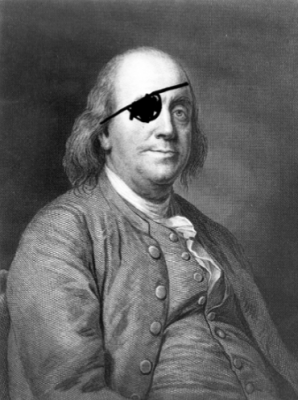
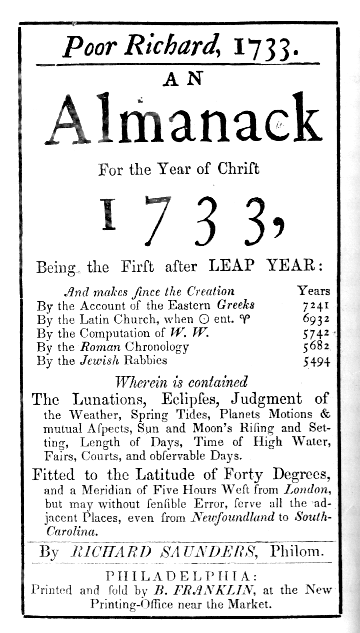
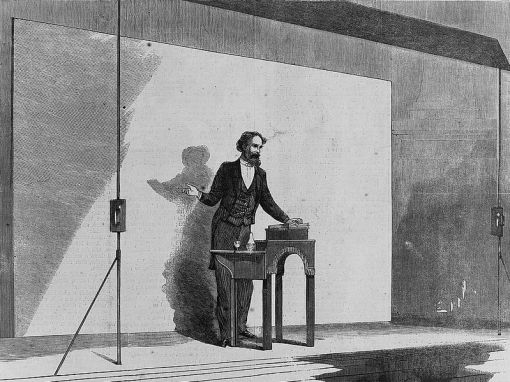
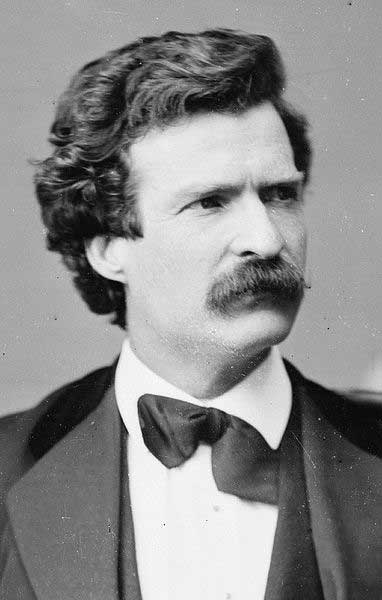
Above, from top: Franklin the pirate (from The First/Last Newspaper); the cover of Poor Richard’s Almanac by Richard Saunders; Dickens gives a public reading during his second visit to America in 1867; Twain the young author and journalist.
One of America’s first pirates was a Philadelphia printer named Benjamin Franklin, who was born in Boston three years before England’s passage of copyright protection with the Statute of Anne in 1709. At 15, Franklin watched his brother James establish the colonies’ first independent newspaper, The New-England Courant. Franklin ran away two years later and soon found himself in London as an apprentice typesetter. By 1726, he had returned to America and found employment in Thomas Denham’s print shop.
For Franklin, piracy was a win-win: money for him, along with revolutionary ideas for a young republic. The scarcity of books in the colonies led Franklin to establish a book-sharing conversation group known as the Junto (or Leather Apron Club), and, later, the Library Company of Philadelphia in 1731. According to the US State Department’s [Outline of American Literature](http://www.america.gov/publications/books/outline-of-american-literature.html), which is available as a free PDF from America.gov, “The unauthorized printing of foreign books was originally seen as a service to the colonies as well as a source of profit for printers like Franklin, who reprinted the works of the classics and great European books to educate the American public.”
Soon after establishing the Library Company, Franklin published the first edition of his famous Poor Richard’s Almanack without copyright protection, and he continued serially updating the book until 1758. At its height, print runs of the Almanack swelled to 10,000 copies a year. It attracted that kind of mass attention, in part, because it began with a literary stunt that Franklin had poached from Anglo-Irish writer Jonathan Swift. During 1708–9, Swift’s fictional character Isaac Bickerstaff had predicted the date of quack author John Partridge’s death and then convinced the public to believe he’d died on that date despite Partridge’s rather vital assertions otherwise. Franklin’s fictional alter ego Richard Saunders, for whom the Almanack is named, did the same to Franklin’s rival publisher Titan Leeds. Swift, who published in Dublin, was, of course, not under copyright. Later, in the 1739 edition of the Almanack, Franklin “borrowed” heavily from an English translation of François Rabelais’s Gargantua and Pantagruel. In essence, Franklin pirated material even in works he actually authored.
“Printers everywhere followed [Franklin’s] lead,” The Outline of American Literature continues. “Matthew Carey, an important American publisher, paid a London agent — a sort of literary spy — to send copies of unbound pages, or even proofs, to him in fast ships that could sail to America in a month. […] Such a pirated English book could be reprinted in a day and placed on the shelves for sale in American bookstores almost as fast as England.” More than 80 years after the Statute of Anne, the great lexicographer Noah Webster would finally draft America’s first copyright law in 1790, but its protections extended only to American authors, and piracy spread further and faster through the colonies than ever before. “The high point of piracy, in 1815,” according to the Outline, “corresponds with the low point of American writing.”
By 1842, when Charles Dickens had published his fifth novel, Barnaby Rudge, the British had strengthened the protections created by the Statute of Anne to better protect it and novels like it from piracy. Dickens — with the help of his friend, the dramatist Thomas Noon Talford — had been lobbying Parliament for copyright reform since the publication of his first novel, The Pickwick Papers, in 1836. (The Pickwick Papers is dedicated to Talford.) Though their first effort at reform had failed, the two finally succeeded in 1842. The current statutes were amended to forbid anyone from importing foreign reprints of any British copyrighted work to Britain or any of its colonies. Further, the British government began actively working with other governments to cultivate reciprocal agreements. With that, Dickens set sail to America.
As Prof. Phillip V. Allingham recounts in his article “Dickens’s 1842 Reading Tour: Launching the Copyright Question in Tempestuous Seas”, Dickens’s crusade to inspire Americans to embrace copyright reform did not go well:
Americans, expecting him to be grateful for their warm reception, were staggered when this young British goodwill ambassador at the beginning of 1842, at a dinner held in his honor in Boston, dared to criticize them as pirates while urging the merits of international copyright, which at that point in American history would have seen vast amounts of Yankee capital heading overseas with little reciprocation. He did not back down. A week later, in Hartford, he argued that a native American literature would flourish only when American publishers were compelled by law to pay all writers their due.
Between visits with author Washington Irving and President John Tyler, Dickens assailed Americans eager to meet their literary hero with the wrongheadedness of their ways. Allingham continues, “That he had not mentioned this issue in advance meant that his adoring audiences, taken by surprise, felt chagrined by the criticisms of this obviously mercenary young upstart who had come to their shores to take their money at the theatre door and again in the bookshop.” Dickens visited America again in 1867–8, at the end of his life. Though seriously ill — he complained of catching a “true American catarrh” — he nevertheless managed to solicit the support of writers Ralph Waldo Emerson and Henry Wadsworth Longfellow for his cause and give 22 readings at Steinway Hall in New York through the dead of winter.
In the audience one cold January night was a 33-year old journalist and budding author named Mark Twain, who’d worked as a printer in New York, Philadelphia, St. Louis, and Cincinnati while educating himself at public libraries in the evenings. After making a comfortable living as a steamboat captain, Twain had found his way westward and reviewed Dickens’s reading for the San Francisco newspaper Alta California, writing of his idol that “Somehow this puissant god seemed to be only a man, after all. How the great do tumble from their high pedestals when we see them in common human flesh, and know that they eat pork and cabbage and act like other men.” Around the same time, Twain’s first book The Celebrated Jumping Frog of Calaveras County appeared in print, though many of its 27 stories had, like Dickens’s, been previously published in newspapers and magazines throughout the country. A travel collection, The Innocents Abroad, was published the following year. It would become Twain’s best-selling book during his own lifetime.
But while his literary stardom would soon rival Dickens’s, he would not enjoy much of his idol’s financial success. Twain squandered his immense fortune on a string of bad investments, sinking the equivalent of millions into a frequently malfunctioning invention called the Paige typesetting machine, a rival and eventual casualty to Ottmar Mergenthaler’s far superior Linotype. Anxious to recoup his losses, Twain penned a letter to Columbia Professor of Dramatic Literature Brander Matthews in 1888 on the subject of copyright reform. Later published as a pamphlet called American Authors and British Pirates by the American Copyright League, the letter concludes,
I think we are not in a good position to throw bricks at the English pirate. We haven’t got any to spare. We need them to throw at the American Congress; and at the American author, who neglects his great privileges and then tries to hunt up some way to throw the blame upon the only nation in the world that is magnanimous enough to say to him, “While you are the guest of our laws and our flag, you shall not be robbed.” All the books which I have published in the last 15 years are protected by English copyright. In that time I have suffered pretty heavily in temper and pocket from imperfect copyright laws: but they were American, not English. I have no quarrel over there. Yours sincerely, Mark Twain.
Three years after Twain’s letter was published, The Chace Act — the first to introduce copyright protection to the works of foreign authors in the United States — would pass in 1891. Americans, who had enjoyed copyright protection on their own works for more than a century, had finally joined the rest of the world.
5 — CAP’N SELLERS’S PEN NAME STOLEN
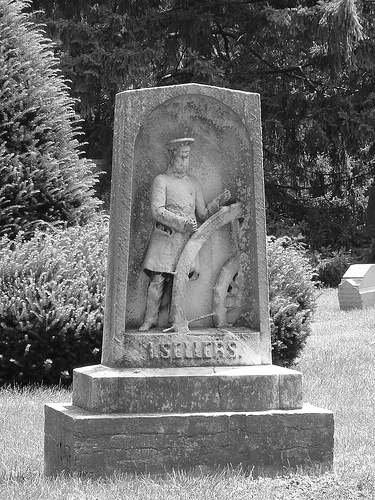
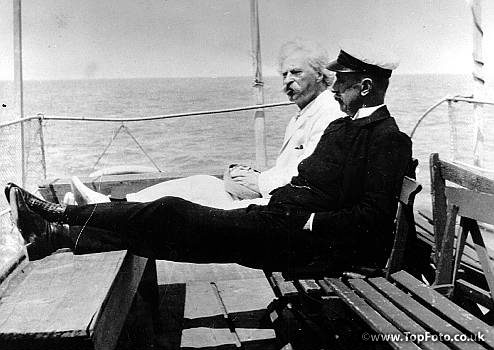
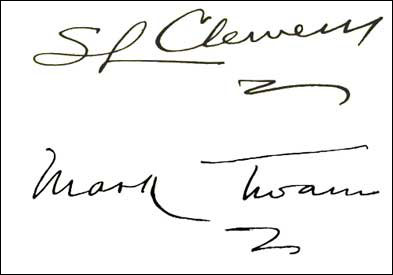
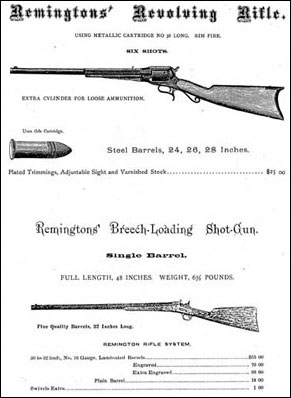
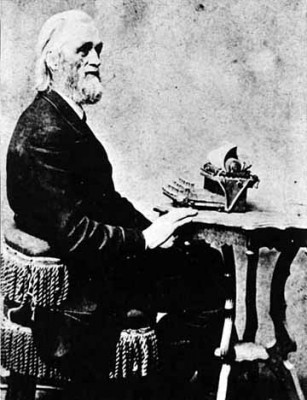
Above, from top: Gravemarker for Isaiah Sellers in Missouri; Twain on a riverboat; signatures as Clemens and Twain; a Remington catalog from the 1880s; Remington typewriter inventor (and newspaper publisher) Christopher Latham Sholes.
Like many of his books, Mark Twain’s 1883 travelogue Life on the Mississippi was published simultaneously in England and the U.S. in an attempt to ensure against piracy on either side of the Atlantic. In it, Twain recounts — among other stories from his young life on the river — the origin of and his decision to use the pen name “Mark Twain” instead of his given name, Samuel Clemens.
Chapter 50 introduces a captain Twain writes is “now many years dead. He was a fine man, a high-minded man, and greatly respected both ashore and on the river.” But he’s a two-sided figure: an able sailor on one hand, but a competitive storyteller on the other. His tales were designed to outdo all the rest. As older pilots bragged about their experiences on the river to newer men, Twain writes, “the stately figure of Captain Isaiah Sellers, that real and only genuine Son of Antiquity, would drift solemnly into the midst.” Capt. Sellers “dated his islands back to the misty dawn of river history; and he never used the same island twice; and never did he employ an island that still existed, or give one a name which anybody present was old enough to have heard of before.” Twain continues,
The old gentleman was not of literary turn or capacity, but he used to jot down brief paragraphs of plain practical information about the river, and sign them “Mark Twain,” and give them to the New Orleans Picayune. They related to the stage and condition of the river, and were accurate and valuable; and thus far, they contained no poison. But in speaking of the stage of the river to-day, at a given point, the captain was pretty apt to drop in a little remark about this being the first time he had seen the water so high or so low at that particular point for forty-nine years; and now and then he would mention Island So-and-so, and follow it, in parentheses, with some such observation as “disappeared in 1807, if I remember rightly.”
In an effort to impress his fellow young pilots, Twain signed his first article for the New Orleans True Delta, which was a parody of the captain’s style with his name, “I. Sellers.” When he found out, Sellers “did me the honor to profoundly detest me from that day forth,” Twain recalls.
He never printed another paragraph while he lived, and he never again signed “Mark Twain” to anything. At the time that the telegraph brought the news of his death, I was on the Pacific coast. I was a fresh new journalist, and needed a nom de guerre; so I confiscated the ancient mariner’s discarded one, and have done my best to make it remain what it was in his hands — a sign and symbol and warrant that whatever is found in its company may be gambled on as being the petrified truth; how I have succeeded, it would not be modest in me to say.
Like Jonathan Swift’s Isaac Bickerstaff or Benjamin Franklin’s Richard Saunders, Clemens used a pen name to antagonize a competitor. And like Dickens’s Boz — which came from “the nickname of a pet child, a younger brother, whom I had dubbed Moses, […] which, being pronounced Bozes, got shortened to Boz” — Clemens kept a pen name not out of spite but as a memento of his youth, a souvenir. Mark Twain represented the best storyteller of them all, casting a long shadow over the young Clemens. Clemens’s nom de plume was not a mask, but a goal. It created another, separate author inside himself. Finally, like copyright, the serial format, and the printing press, Twain’s pseudonym was a text-generating tool: with it, he could make more text and better text at a faster rate than he ever could as Samuel Clemens.
Beyond revealing the origin of his name, however, Twain’s Life on the Mississippi was unique for another reason: it was the first manuscript to be composed entirely on a typewriter, the Remington Model 2. The typewriter was Twain’s second. He’d purchased a Remington Model 1 in 1874, just seven years after Christopher Latham Sholes, working with Carlos Glidden and Samuel Soule, had invented it. Sholes described his contraption as “a cross between a loom and a jack-in-the-box, but it could operate faster than a man could with a pen, and all the letters were legible.” Sholes’s typewriter was not the first — a British inventor named George Mill had filed a patent for a “writing-machine” shortly after the passage of the Statue of Anne in 1714 — but it was the first to be industrially produced.
Since the conclusion of the Civil War in 1865, the famous firearms manufacturers E. Remington & Sons had turned their wartime production line to the production of domestic goods, like sewing machines. Remington’s engineers felt many of the same technologies developed for the sewing machine could be applied to the typewriter. Their version of Sholes’s machine sat on a stand “similar to a sewing machine table,” according to a [1977 IBM press release][10] on the typewriter’s history, and “the carriage was returned by means of a foot-treadle.” Remington’s advertising noted that the typewriter was “the size of a sewing machine, and an ornament to an office, study, or sitting room.”
The similarity to the sewing machine may explain why society was so quick to train women to use the new technology. By 1878, the year the Remington 2 was introduced, schools in New York offered typing courses for students, and soon after that the New York YWCA began offering secretarial instruction to young ladies. Female stenographers would soon be found in better hotels and office supply shops throughout the country, and it was just such a woman who first cast a spell on Twain with the new machine and prompted him to buy it. In his unpublished autobiography — a set of sheets dictated, of course, to a secretary with the aid of a typewriter — Twain recounts his purchase:
Nasby and I saw the machine through a window, and went in to look at it. The salesman explained it to us, showed us samples of its work, and said it could do fifty-seven words a minute — a statement which we frankly confessed that we did not believe. So he put his type-girl to work, and we timed her by the watch. She actually did the fifty-seven in sixty seconds. […] She did her work on narrow slips of paper, and we pocketed them as fast as she turned them out, to show as curiosities. The price of the machine was one hundred and twenty-five dollars. I bought one, and we went away very much excited. At the hotel we got out our slips and were a little disappointed to find that they contained the same words. The girl had economized time and labor by using a formula which she knew by heart.
But Twain’s Remington Model 1 was “full of defects — devilish ones,” and he was eager to get rid of it. He gave it first to his friend Howells, who “was reluctant, for he was suspicious of novelties and unfriendly towards them, and I got him to believe things about the machine that I did not believe myself. He took it home to Boston, and my morals began to improve, but his have never recovered. He kept it six months, and then returned it to me.” Twain then tried to unload it on his coachman, Patrick McAleer, “who was very grateful, because he did not know the animal, and I thought I was trying to make him wiser and better. As soon as he got wiser and better he traded it to a heretic for a side-saddle which he could not use, and there my knowledge of its history ends.” Passing, like Twain’s own pen name, from one person to the next, it seemed the Remington Model 1 had a mind of its own.
6 — REMINGTON LAUNCHES GHOSTWRITER
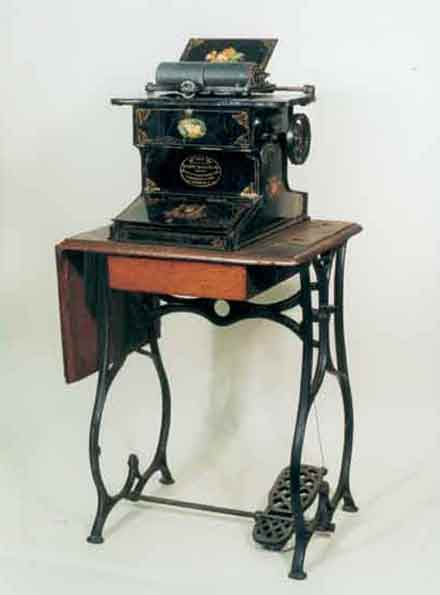

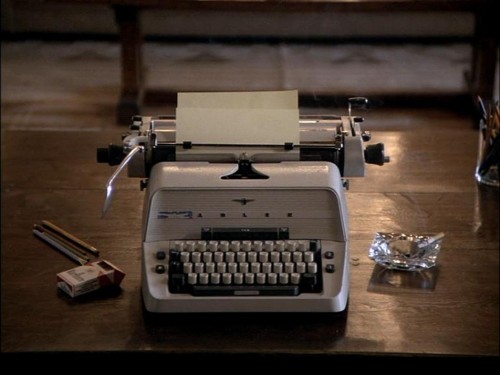
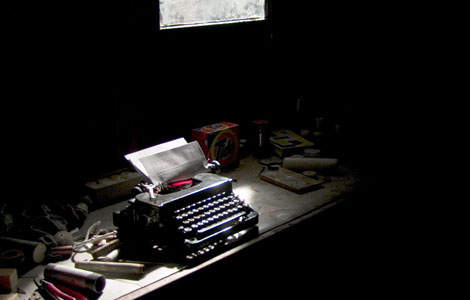
Above, from top: a Sholes & Glidden c. 1873, the model used by Mark Twain; a Hansen Writing Ball c.1882, the model used by Friedrich Nietzsche; the Adler typewriter found on the desk of Jack Torrance in a still from The Shining; the Smith-Corona on the desk of Theodore Kaczynski (aka the Unabomber) in a photograph of his Montana cabin.
Shortly after buying his Remington Model 1 typewriter, Mark Twain dashed a letter off to his brother in 1874. In his note, he seems equal parts addled and satisfied with his new purchase:
I am trying get the hang of this new fangled writing machine, but am not making a shining success of it. […] I believe it will print faster than I can write. One may lean back in his chair & work it. It piles an awful stack of words on one page. It don’t muss things or scatter ink blots around. Of course it saves paper.
Knowing they had a notable writer for a customer, Remington’s salespeople contacted Twain to see if he’d vouch publicly for their Remington Model 2, which he’d purchased as soon as it was released. In a typed note of all caps he declined, signing off not as Twain, but with his given name, Samuel Clemens:
Please do not use my name in any way. Please do not even divulge the fact that I own a machine. I have entirely stopped using the Type-Writer, for the reason that I never could write a letter with it to anybody without receiving a request by return mail that I would not only describe the machine but state what progress I had made in the use of it, etc., etc. I don’t like to write letters, so I don’t want people to know that I own this curiosity breeding little joker. Yours truly, Saml. L. Clemens.
It’s easy to speculate as to why Twain might’ve signed his note as Clemens. He routinely signed “Sam” to friends and used Clemens both in business and for personal notes. Perhaps he didn’t want his more famous pen name used in any way with Remington’s products, so he refused to even sign it. But it also seems at least a little bit possible that, when he wrote as Twain, Clemens felt he had a kind of creative power he did not possess as Clemens alone; but, when he wrote with the Remington, Clemens may have felt it had a power over him, and even over Twain, that made them both uncomfortable, even anxious. “Mark Twain” started out not as a given name but as a sailor’s pseudonym. Before that it was a sailor’s call — “mark twain!” — meaning the river’s depth was 2 fathoms (12 feet) deep, and the boat could navigate its passage safely. When Clemens selected Mark Twain, he selected not only a the name of a storyteller but the sign of a technician, who, with this piece of information, could signal the crew that the ship was in control and could be guided safely down its course. “Cybernetics,” which is the study of communication and control between humans and machines, takes its name from the Greek “kybernetes,” who is the oarsman, pilot, or rudder: the one who can skillfully bring a boat to port. Clemens’s pseudonym, Twain, was another name for the author himself. But, according to his letters, his typewriter often behaved as an allonym — a ghostwriter. While the pen name Twain helped to put Clemens in control of the writing process, the Remington’s ghostwriter effect counteracted that control, placing the invention of text somehow just beyond its operator’s reach, or total understanding.
Like Twain, German philosopher Friedrich Nietzsche’s experience with his Hansen Writing Ball, a typewriter Nietzsche purchased in 1882 directly from its inventor, seemed somehow beyond his control — even supernatural. Living in Genoa with his eyesight failing, Nietzsche hoped the writing ball would make it easier for him to write away from home, but he arrived to find his machine damaged in transit. The Hansen’s already fussy keys only became more difficult in inclement weather. “The typewriter has been unusable since my last card,” Nietzsche wrote, “for the weather is dreary and cloudy, that is, humid: then each time the ribbon is also wet and sticky, so that every key gets stuck, and the writing cannot be seen at all.” The typewriter, which was meant to free Nietzsche from his pen and make it easier for him to write, had left him blocked. No longer in control of his own output, Nietzche’s productivity would now rise and fall with the barometer. By 1882, he’d pounded out a well-known poem, which reads, “The Writing Ball is a thing like me: of iron / Yet twisted easily — especially on journeys. / Patience and tact must be had in abundance / As well as fine [little] fingers to use it.” As Prof. Friedrich Kittler points out in his study Gramophone, Film, Typewriter, in Nietzsche’s poem, “three moments of writing coincide: the equipment, the thing, and the agent. An author, however, does not appear […] Our writing tool not only works on our thoughts, it ‘is a thing like me.’”
Nietzsche would soon give up his typewriter, but he would never dismiss it entirely. In one of his last typewritten letters, he observes, “This machine is delicate as a little dog and causes a lot of trouble — and provides some entertainment. Now all my friends have to do is invent a reading machine: otherwise I will fall behind myself and won’t be able to supply myself with sufficient intellectual nourishment.” Nietzsche feared his own typewriter might outproduce him. Its mechanistic drive to produce text faster than its owner could read it harkens back to the scene that Twain described previously, when he was first entranced by the typewriter in the shop. 57 words a minute! If only he could write that fast. But recall that the salesgirl who’d impressed Twain had a trick: she always typed the same text, over and over and over again. In Stanley Kubrick’s The Shining, in a touchstone image of typewriter-as-ghostwriter, the ceaselessly repeated typescript reappears when Wendy discovers that her husband Jack’s novel isn’t a novel at all. Instead, he has typed “All work and no play makes Jack a dull boy” on sheet after endless sheet. Jack isn’t using his Adler typewriter; the Adler is using him. Realizing her husband has lost his mind, Wendy’s face pales, terrified.
Kubrick’s film is fictional, but cautionary. Kittler, too, tells of a 1941 detective play by Jean Cocteau called La Machine à écrire (The Typewriter) involving “an unknown woman who has been tormenting her community with anonymous typewritten letters.” Kittler continues, “[the detective] ‘imagines the culprit at work at her typewriter, aiming and operating her machine gun.’ Typewriters are simply ‘fast,’ not just ‘like Jazz’ […] but also like rapid-fire weapons.” When Cocteau’s antiheroine finally confesses, she explains, “I wanted to attack the whole city. […] I wanted to stir that muck, attack and reveal it. It was like a hoax! Without accounting for myself, I chose the dirtiest and cheapest of all weapons, the typewriter.” She terrorizes the city with the stroke of a key.
A vividly real and far more terrorizing letter from an anonymous typist was received by the New York Times on 26 April 1995. It had been keyed on an old machine later identified as a 1920s-era L.C. Smith-Corona. Enclosed was a lengthy typewritten manifesto that began, “The Industrial Revolution and its consequences have been a disaster for the human race.” The New York Times shared the letter with the FBI, who explained that it was from a domestic terrorist known as the Unabomber. The letter demanded that the manifesto be published “in the New York Times, Time, or Newsweek, or in some other widely read, nationally distributed periodical,” and, it promised, “if you can get it published according to our requirements we will permanently desist from terrorist activities.” As for the text, its author stipulated that “after six months from the first appearance of the article or book it must become public property, so that anyone can reproduce or publish it.” Also: “because of its length, we suppose it will have to be serialized.”
The Washington Post instead opted to print the text whole as a four-page supplement that September. It would prove to be the Unabomber’s undoing. The following April, authorities raided the one-room cabin of a former UC Berkeley professor named Theodore Kaczynski, whose brother had called in a tip that Kaczynski’s writings reminded him the Unabomber’s. By the time they finished their search, they’d found the smoking gun: amidst firearms, handmade bombs, and various disguises, sitting on a desk littered with carbon copies of the letters and manifesto, was the Smith-Corona.